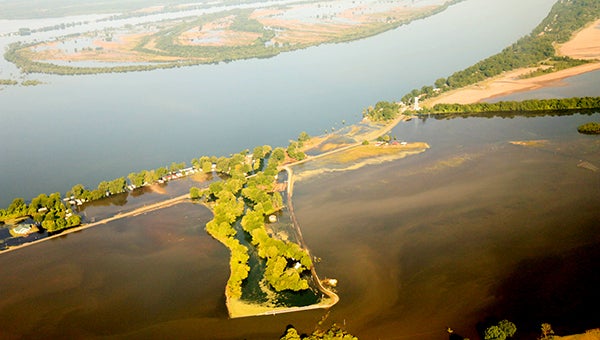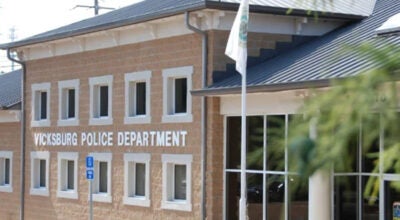Backwater pumps could take five years to build, Corps engineer says
Published 2:58 pm Monday, February 3, 2020

- An aerial photograph of flooding in the Eagle Lake area taken in July 2019. (Walter Frazier/ The Vicksburg Post)
If the Environmental Protection Agency gave its blessing to install the Steele Bayou pumps immediately, it would be five years before they would be ready to relieve backwater flooding, a Corps of Engineers official said Saturday.
“If it is approved, and when it’s approved, and they throw the packet across the fence to us, it will probably take close to two years to design and close to two years to construct,” said Henry Dulaney, chief of the engineering and construction division for the Corps’ Vicksburg District.
“If they gave us today approval to do it, it’s going to be several years before you would see it in action,” he said.
His comments came during a meeting of Eagle Lake and Yazoo Backwater Area residents Saturday afternoon at Eagle Lake United Methodist Church to discuss potential high water concerns. The status of the pump project was just one of the concerns raised at the meeting.
The Steele Bayou pump station, which was to be built on the Steele Bayou Control Structure to help protect the South Delta from flooding, was vetoed by the Environmental Protection Agency in 2008.
Dulaney said some of the design for the project has been done, “But the standards have changed since that design was done, so we will have to start back close to somewhere between 10 to 20 percent on the design, because that is not very useful. That is disappointing to us.”
If the project is approved, Vicksburg District Commander Col. Robert Hilliard said, the Corps would still have to submit a funding request, and the earliest that could be is October. “That (project) funding is not there right now,” he said.
The pump station is the final piece of the Yazoo Backwater Project that was authorized by Congress in 1941. The major piece of the project was the Yazoo Backwater Levee, completed in 1978. In 2007, the year before the EPA vetoed the project, its cost was estimated at $220 million. An updated estimate has not been determined.
The pumps are expected to move 14,000 cubic feet of water per second from the land or Delta side of the structure to the riverside if and when gates are closed due to high river stages.
Designs had it protecting about 630,000 acres in the South Delta from flooding. Flooding to residential and non-residential structures in the Delta would be reduced by 68 percent when the pump station is completed, according to a report from the Corps.
The EPA took into account multiple revisions in the plan in its veto but concluded the project would adversely affect area wetlands and wildlife.
The project took on new life during the 2019 flood when backwater area flooding reached a record level of 98.2 feet.
Hilliard said the Corps is continuing to discuss the project with EPA officials.
“We’ve been meeting with the EPA the last 6 to 8 months,” he said, adding Mississippi Valley Division Commander Lt. Gen. Mark Toy met with the EPA Region IV director in October.
“We have committed as a district to provide updated data that we’ve been gathering with ERDC (U.S. Army Engineer Research and Development Center) on the backwater area,” Hilliard said. “We have gathered precipitation data that basically says 87 percent of the wetlands are maintained by precipitation. That’s been published and provided with other information on water quality to the EPA.”
The EPA, he said, is reviewing the data.
From the Corps’ perspective, he said, “We are committed to the project and we are getting the attention it deserves.”
The residents also told county, state and federal officials Saturday they want better communication between officials and the community over issues involving flooding and the progress of programs like the pumps project.
“Is there something that maybe the Corps (of Engineers) or somebody can get together and put up a website so we can get an official announcement (on issues)?” one resident asked state Rep. Kevin Ford, R-Vicksburg.
“You get, ‘Well, I heard this and I heard that,’ and then next thing you know, this wasn’t true but this was partially true,” the man said, adding updated information from the Corps or another agency could help people get accurate information, “So there’s no guesswork where you’re at.”
Hilliard said the Corps and other officials needed to do a better job getting the information out “so we can speak with one voice.”
Warren County Board of Supervisors President Jeff Holland said all five supervisors were at the meeting, adding, “I hope you understand by all five of us being here today that our intent is to show you that we’re going to pay attention and that we want to communicate with you.
“You need to think about how you want us to communicate with you,” he said, pointing out the residents had mentioned communication several times during the meeting, “And identified the need for communication.
“You need to help us understand how else you would like us, the Board of Supervisors, to communicate with you; how you’d like the county to communicate with you and to the best we are able to do that, we will. Help us understand that,” Holland added.
Several residents discussed problems they wanted help resolving from the county. Holland said he would research what the county can do under state law to help the residents.






